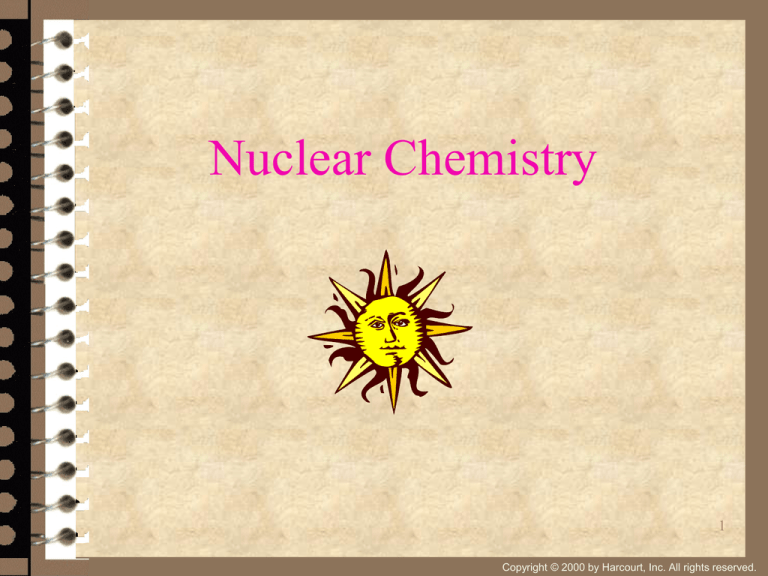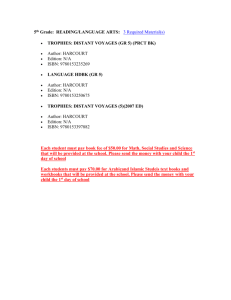
Nuclear Chemistry
1
Copyright © 2000 by Harcourt, Inc. All rights reserved.
Comparison Of Chemical and
Nuclear Reactions
Chemical Reactions
1 No new elements can be produced.
2 Usually only the outer most electrons participate
3 Release or absorb relatively slight amounts of
energy.
4 Rate of reaction depends on factors such as
concentration, pressure, temperature, and
catalysts.
2
Copyright © 2000 by Harcourt, Inc. All rights reserved.
Comparison Of Chemical and
Nuclear Reactions
Nuclear Reactions
1 Elements may be converted from one to another.
2 Particles within the nucleus are involved.
3 Release or absorb immense amounts of energy.
4 Rate of reaction is not influenced by external
factors.
3
Copyright © 2000 by Harcourt, Inc. All rights reserved.
Beginning of Nuclear Science
1896 - Henri Becqurel
– discovers radioactivity in U salts
1898 - Marie and Pierre Curie
– discover two new radioactive elements
– Po and Ra
1898 - Ernest Rutherford
– discovers that radioactivity has two forms
a and b radiation
4
Copyright © 2000 by Harcourt, Inc. All rights reserved.
Radioactive decay (transmutation)
During nuclear reactions atoms can change
into new elements through radioactive
decay
When balancing reactions make sure the
mass numbers and atomic numbers before
and after the arrow are equal
5
Copyright © 2000 by Harcourt, Inc. All rights reserved.
Several types of
radioactive decay
Nuclide too large – alpha
4
2
He or 24a
Too many neutrons Beta minus (electron)
b or -10 e
0
-1
Too many protons, Beta plus (also called a
positron or electron capture)
0
1
b or
0
1
e
Copyright © 2000 by Harcourt, Inc. All rights reserved.
Other types of particles used
during radioactive decay
Neutron
Proton
1
0
1
1
n
p
or 11 H
Gamma (high energy including x-rays)
heavy proton
2
1
0
0
H
7
Copyright © 2000 by Harcourt, Inc. All rights reserved.
Examples
1)
218Po
2)
253Es
3)
142Pm
• 7
1
0
n
=
+
4
2
He
a
4
2
+ ?
? +
+ ?
7 x 1 7
7 x 0 0
1
0
n
142Nd
instead of 01 n +01 n +01 n +01 n +01 n +01 n +01 n
4
2
• Try 4 He
8
Copyright © 2000 by Harcourt, Inc. All rights reserved.
Main Types of Radiation
Alpha (2 protons and 2 neutrons) 42 He or 24a
Beta (electron)
b
0
-1
or
0
-1
e
Gamma (including x-rays)
0
0
Copyright © 2000 by Harcourt, Inc. All rights reserved.
Radiation Interaction with Matter
Copyright © 2000 by Harcourt, Inc. All rights reserved.
Alpha particles – first to be discovered
Ra
226
88
Radium-226
Pb
222
86
Radon-222
??
??
alpha particle
??
Mass number must = 4
Atomic number must = 2
So an alpha particle is 2 protons and 2
neutrons, and has a charge of +2.
The element Helium has a mass of 4 and an
atomic number of 2, so the alpha particle is
just like a helium atom without any electrons
11
Copyright © 2000 by Harcourt, Inc. All rights reserved.
Beta particles
C N
14
6
Carbon-14
14
??
7
??
Nitrogen-14 beta particle
??
Mass number must = 0
Atomic number must = -1
The electron has a mass of zero and a charge of
-1, so the beta particle is just like an electron;
Beta particles are produced when a neutron
changes into a proton; an electron is ejected
from the nucleus
12
Copyright © 2000 by Harcourt, Inc. All rights reserved.
Gamma rays – last to be found
238
92
U
Th He
234
90
4
2
Uranium-238 thorium-234 alpha particle
??
??
??
gamma ray
Mass number must = 0
Atomic number must = 0
The gamma ray has no mass and no charge;
Gamma rays usually occur with alpha and beta
radiation
They account for most of the energy lost during
radioactive decay
13
Copyright © 2000 by Harcourt, Inc. All rights reserved.
14
Copyright © 2000 by Harcourt, Inc. All rights reserved.
Alpha particles (+ charge) deflect towards the
negative plate
Beta particles (- charge) deflect towards the
positive plate
Gamma rays (no charge) are not deflected at all
15
Copyright © 2000 by Harcourt, Inc. All rights reserved.
Detecting Radiation
What do you need in order to detect radiation?
– Material for interaction
– Method of measuring the interaction
Typical detectors include
– Gas filled counters, semiconductor based
(Geiger counters)
– Luminescent film (Photographic detection)
– Florescent detection (Scintillators absorb
energy and then emit visible light)
Copyright © 2000 by Harcourt, Inc. All rights reserved.
Fission and Fusion
Nuclear fission (fizzing like pop rocks or
shaking a coke)
– splitting of a heavy nucleus into two lighter
nuclei
Nuclear fusion (fusing two things together)
– combining two light nuclei into one heavier
nucleus
Both processes generate enormously large
amounts of energy
17
Copyright © 2000 by Harcourt, Inc. All rights reserved.
Fusion
Fission
Merge (makes heavier
products)
Release tremendous
amounts of energy
Produces no radioactive
waste
Hydrogen + Hydrogen
Helium
Involves changes in the
atom at the subatomic
level
Currently not feasible
Split up (makes lighter
products)
Release tremendous
amounts of energy
Produces radioactive
waste
Uranium lots of smaller
radioactive elements
Involves changes in the
atom at the subatomic
level
Used at nuclear reactors
18
Copyright © 2000 by Harcourt, Inc. All rights reserved.
Nuclear Fusion
Fusion is the most energetic process in nature.
– energy source of stars, fusion reaction is in the
main sequence of stars
– produces chemical elements
– potential energy source for humans
Thermonuclear or hydrogen bombs have been
in existence since the 1950’s
2
1
H H He n energy
3
1
4
2
1
0
19
Copyright © 2000 by Harcourt, Inc. All rights reserved.
Nuclear Fusion
(Thermonuclear) Energy
Controlled nuclear fusion
– must occur at temperatures of 10 million oC
Fusion reactors must contain this temperature
and not melt!
Some fusion reactors exist around the world
– Although none can currently generate a
sustainable fusion reaction
Possible energy source for the 21st Century
20
Copyright © 2000 by Harcourt, Inc. All rights reserved.
Nuclear Fission
Most nuclides with atomic numbers greater
than 80 are able to undergo fission
– They split into nuclei of intermediate (smaller)
masses and emit one or more neutrons
Some fission reactions are spontaneous while
others require activation, usually by neutron
bombardment (hit by a neutron).
21
Copyright © 2000 by Harcourt, Inc. All rights reserved.
Nuclear Fission – chain
reaction
Some possible fission paths for 235U are
(after bombardment by a neutron)
22
Copyright © 2000 by Harcourt, Inc. All rights reserved.
Nuclear Reactors (Fission)
Electricity can be generated from steam
heated by nuclear fission reactions. Nuclear
power is a cost effective and relatively safe
way to produce power
Greatest danger of nuclear reactors is core
meltdown.
23
Copyright © 2000 by Harcourt, Inc. All rights reserved.
Serious nuclear reactor accidents:
– Three Mile Island, PA (1979) Nuclear reactor
malfunctioned – no meltdown, but some
radioactive contamination. Affected a 25 mile
radius
– Chernobyl , Russia (1986) Nuclear reactor’s
cooling system failed – meltdown. Released
thirty times the radioactivity of the atomic
bombs dropped on Hiroshima and Nagasaki.
31 lives were lost immediately. Radiation in
soil & atmosphere still presents significant
health risks.
24
Copyright © 2000 by Harcourt, Inc. All rights reserved.
– Japan (2011) After the earthquake and tsunami
that hit Japan in 2011. The cooling system of
the nuclear power plant in Fukushima failed
causing the reaction to spiral out of control. The
heat produced by the reaction caused the
Uranium to decay to Cesium 137, a very
unstable atom that caused most of the
environment to become radioactive. This has
caused the area to become a dead zone.
25
Copyright © 2000 by Harcourt, Inc. All rights reserved.
Nuclear Reactors (Fission)
Fuel - 235UO2 or 239Pu
Moderator – a material usually graphite or water that
slows neutrons from fast to thermal
Control Rods - removes neutrons and slows the chain
reaction
– usually made of boron, efficient neutron absorber
Shielding - protection from radiation
– lead and concrete are commonly used
Cooling Systems - reactor core must be cooled to remove
heat
– possible coolants: water, helium, and liquid sodium
26
Copyright © 2000 by Harcourt, Inc. All rights reserved.
Turning Heat into Electricity
BWR:
Boiling Water Reactors
PWR:
Pressurized
Water Reactors
Copyright © 2000 by Harcourt, Inc. All rights reserved.
Comanche Peak
Copyright © 2000 by Harcourt, Inc. All rights reserved.
Radiation all around us
Naturally occurring radiation
– K-40, Thorium, Radium
– Cosmic
Radiation in household products
– Fiestaware
• (1936 – 1959) used U
• (1959 – 1973) used depleted U
– Fire Detectors
• Uses Americium-95
– Antique Clocks and watches
• Used Radium which glows in the dark
• 1917 – women who worked at the U.S. Radium Factory
were told that the Ra was harmless. They ingested deadly
amounts of Ra and in turn became incredibly ill. This is an
important time in history for labor rights
Copyright © 2000 by Harcourt, Inc. All rights reserved.
Health concerns
Acute radiation to cells causes them to
divide and grow without control – this
creates a tumor (cancer)
*More harmful to children than adults
30
Copyright © 2000 by Harcourt, Inc. All rights reserved.
Health benefits
Radiation can be used to actually destroy
cancerous growths
Medical Field - Wide spread use in medical
imagining and diagnostics.
–
–
–
–
–
CT Scans
PET Scans
X-rays
Cancer Treatments
Radioactive barium used in “milkshakes” for
colon exams.
31
Copyright © 2000 by Harcourt, Inc. All rights reserved.
More benefits
Many uses of nuclear radiation in industry,
agriculture, space research
– used in archaeology, biology, physics,
chemistry, cosmology
Food Industry
– Food is sometime irratdiated to kill the bacteria
that causes food to spoil
Crime Scene Investigations
32
Copyright © 2000 by Harcourt, Inc. All rights reserved.
Radioactive Dating
Carbon dating can be used to estimate the ages of
items of organic origin.
14C is produced continuously in the upper atmosphere
by the bombardment of 14N by cosmic-ray
neutrons:
14C atoms then react with O to form CO
2
2
– CO2 then is incorporated into plant life by
photosynthesis.
After material dies 14C content decreases from
radioactive decay ~ 14C half-life is 5730 years.
33
Copyright © 2000 by Harcourt, Inc. All rights reserved.
Half life the amount of time it takes for half of
a sample to decay.
Ex. the half life of carbon-14 is 5730 years.
– This means that if you start with 24 grams of
carbon 14, 5730 years later you will have 12 grams,
5730 years after that you will have 6 grams, 5730
years after that you will have 3 grams.
Copyright © 2000 by Harcourt, Inc. All rights reserved.
35
Copyright © 2000 by Harcourt, Inc. All rights reserved.
Mythbusters
●
Myth #1
Americans get most of their yearly radiation
dose from nuclear power plants
Dental X-ray ~ 1 mrem
●Natural Radiation ~ 30 mrem per yr
●3 hour flight ~ 1.5 mrem
●Living within 50 miles of a Nuclear plant ~0.01 mrem
●
Copyright © 2000 by Harcourt, Inc. All rights reserved.
Mythbusters
Myth #2
●
A nuclear power plant can explode like a
nuclear bomb
–It
is impossible for a reactor to explode like a bomb.
– Bombs require much, much, much higher levels of
fuel enrichment and must be configured in a specific
geometry
– Neither of which are present in a power plant
Copyright © 2000 by Harcourt, Inc. All rights reserved.
Mythbusters
Myth #3
●
The smoke you can see from a cooling
tower is radioactive
–
The `smoke' is actually water vaper. The water is
very clean and has no detectible radiation
Copyright © 2000 by Harcourt, Inc. All rights reserved.
Mythbusters
Myth #4
●
An event similar to Chernobyl can happen
in the USA
The Chernobyl design is vastly different than what is operating
in the US
– Chernobyl used graphite as a moderator not water
– Graphite has postive reactivity coefficient, water has a
negative reactivity coefficient
– Chernobyl did not have containment, American reactors have
3 levels of containment
Fuel Rod, Reactor Vessel, and Containment building
–
Copyright © 2000 by Harcourt, Inc. All rights reserved.
Nuclear science has been one of the driving
forces of science in the 20th Century.
40
Copyright © 2000 by Harcourt, Inc. All rights reserved.







